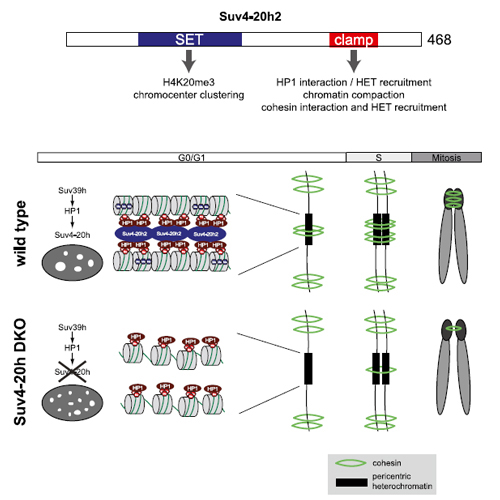Suv4-20h2 mediates chromatin compaction and is important for cohesin recruitment to heterochromatin
18-Apr-2013
Genes & Dev., 2013, doi: 10.1101/gad.210377.112, published on 18.04.2013
Genes & Dev., online article
Genes & Dev., online article
Cohesin plays an important role in chromatid cohesion and has additional functions in higher-order chromatin organization and in transcriptional regulation. The binding of cohesin to euchromatic regions is largely mediated by CTCF or the mediator complex. However, it is currently unknown how cohesin is recruited to pericentric heterochromatin in mammalian cells. Here we define the histone methyltransferase Suv4-20h2 as a major structural constituent of heterochromatin that mediates chromatin compaction and cohesin recruitment. Suv4-20h2 stably associates with pericentric heterochromatin through synergistic interactions with multiple heterochromatin protein 1 (HP1) molecules, resulting in compaction of heterochromatic regions. Suv4-20h mutant cells display an overall reduced chromatin compaction and an altered chromocenter organization in interphase referred to as “chromocenter scattering.” We found that Suv4-20h-deficient cells display chromosome segregation defects during mitosis that coincide with reduced sister chromatid cohesion. Notably, cohesin subunits interact with Suv4-20h2 both in vitro and in vivo. This interaction is necessary for cohesin binding to heterochromatin, as Suv4-20h mutant cells display substantially reduced cohesin levels at pericentric heterochromatin. This defect is most prominent in G0-phase cells, where cohesin is virtually lost from heterochromatin, suggesting that Suv4-20h2 is involved in the initial loading or maintenance of cohesion subunits. In summary, our data provide the first compelling evidence that Suv4-20h2 plays essential roles in regulating nuclear architecture and ensuring proper chromosome segregation.











